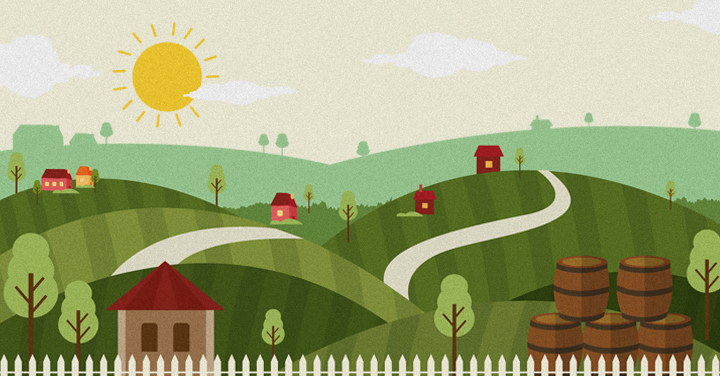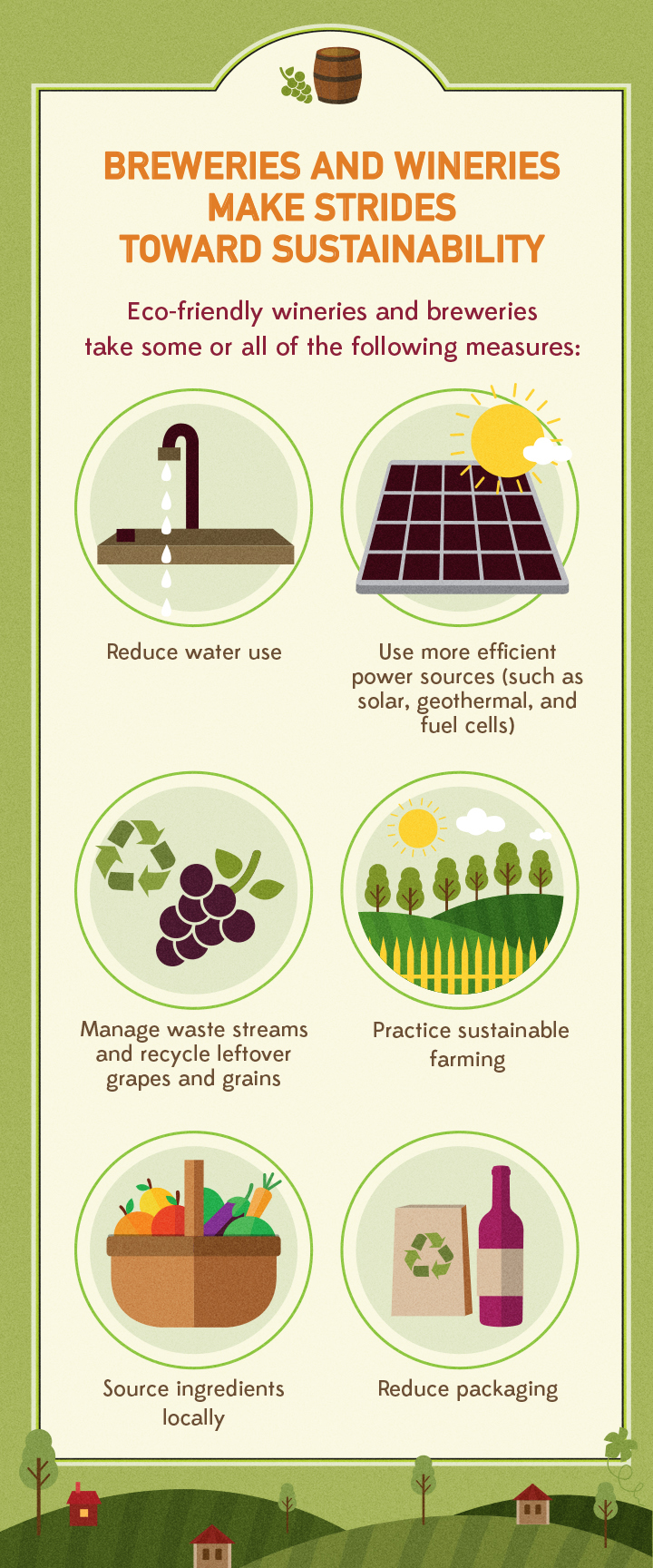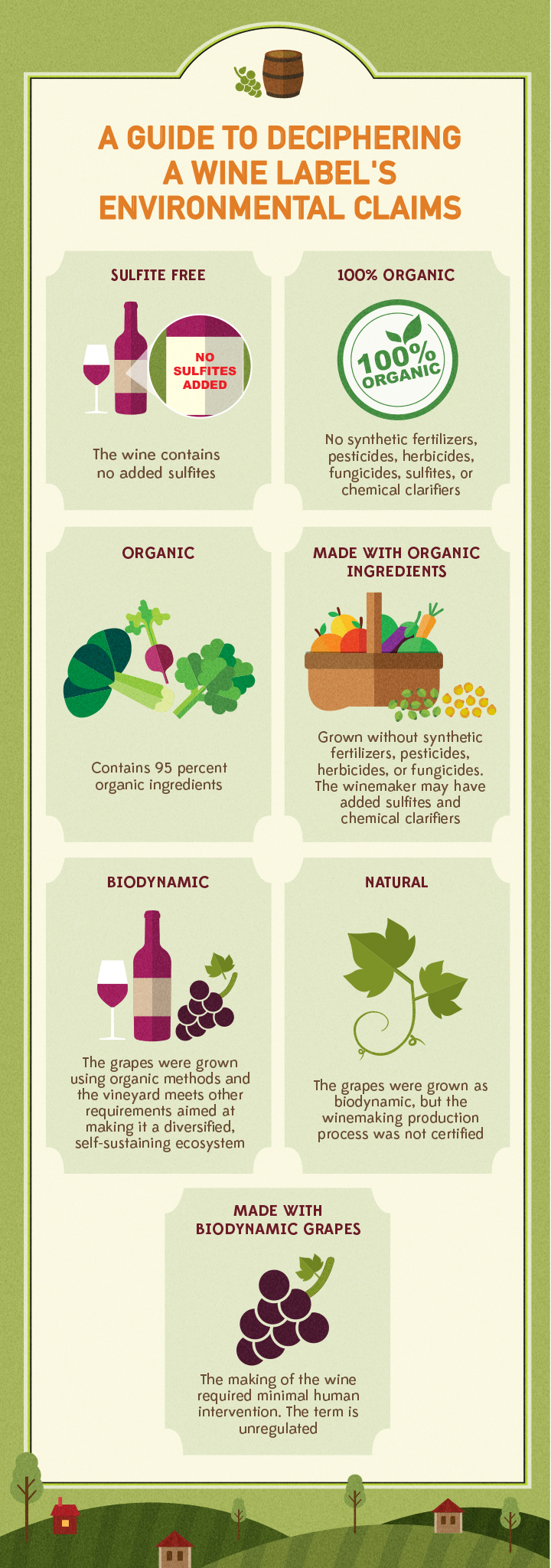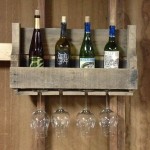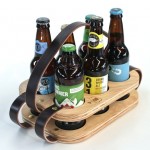Green Breweries and Wineries
Americans consume 9.4 billion gallons of alcoholic beverages a year: 87 percent beer, 8 percent wine, and the rest spirits. The environmental impact of producing, packaging, and selling all those beverages could make an environmentalist reach for a drink. Breweries and wineries consume large quantities of water, raw materials, and other natural resources.
But there’s good news: Green beer is no longer something people drink just on Saint Patrick’s Day. With the rise of the craft beer movement and growing consumer interest in local and sustainable food, more breweries and wineries are working to reduce the beverage industry’s environmental footprint. As a result, it’s easier to stock the home bar with sustainable, organic brews.
Moving Toward Sustainability
Sustainability is a buzzword these days, but what does it really mean? Ideally, it indicates a company uses resources in non-depleting ways while fostering the health of the company, workers, planet, and future generations. No beer and wine companies are entirely sustainable—at the moment they all use more resources than they return—but many mitigate environmental damage in several key ways.
-
Slash water use
Beverage companies are particularly reliant on water, one of our most critical natural resources. Conscientious businesses work to be its responsible stewards. According to a 2008 report, viticulturists on California’s North Coast use an average of 75 gallons of water to grow the grapes for just one gallon of wine, and in the state’s drier Central Valley, they use 430 gallons of water per gallon. Turning the grapes into wine uses six more gallons of water. To reduce that footprint, many wineries have installed low-flow nozzles and filtration systems, and reuse gray water from the production process. A minority employ dry farming, which means growing grapes without irrigation, a practice that can save millions of gallons of water a year.
A gallon of beer requires five to 10 gallons of water to produce. Craft brewers are leading a movement to reduce that ratio (Oregon’s Full Sail Brewery boasts a 2.5 to 1 ratio) and even the world’s largest brewers, including Anheuser Busch, MillerCoors, and Heineken, are cutting water usage.
-
Power down
From heating water vats and refrigerating beverages to lighting tasting rooms, the mass production of beverages is energy intensive. Eco-minded companies make their systems more efficient, install solar panels and solar hot water heaters, and utilize technologies such as fuel cells, geothermal heating, and carbon dioxide reclamation.
-
Manage waste streams
The majority of waste in the brewing process is spent grain. Breweries have a long history of passing spent grain on to farmers to feed cattle, chickens, pigs, and other livestock. Some are coming up with other innovative ways to use leftover grains, including making bread and composting. One brewery developed a biomass steam boiler that allows them to power brewery operations with spent grain. Conscientious vintners recycle pomace—spent grape seeds, pulp, and skins—in the winemaking process, compost it, or sell it to manufacturers of grape fruit oil, cream of tartar, or spirits. Many beer and wine companies have installed on-site wastewater treatment plants and/or reuse cardboard, pallets, and other packaging waste.
-
Farm sustainably
Beer and wine are agricultural products, so to make a sustainable beverage, the ingredients must be grown in ways that contribute to the health of ecosystems, wildlife, and workers. Unfortunately so far organic beer and wine have constituted a small share of the beverage industry. Brewers cite the expense and shortage of organic hops and barley. And wine consumers have equated organic with low quality. But that seems to be changing. According to a recent study, the organic beer and wine market is expected to grow at a rate of 24.5 percent from 2013 to 2019.
-
Source local ingredients
Wineries have a long history of growing grapes on site. Now a farm-to-pint movement is making waves in the craft beer industry. From Oregon to New York, local economies are springing up around craft beer with a new crop of farmers at the base. By localizing supply chains, beverage companies cut down on the transport of raw ingredients—a large portion of most companies’ carbon footprint. They can also more easily reuse resources that would leave the facility—including water and packaging—in the production process. For instance, they can use gray water to irrigate fields.
-
Reduce packaging
It doesn’t get much greener than a reusable jug, so it’s promising The Wall Street Journal called the warm months of 2013 “the summer of the growler.” Sure enough, grocery, drug, and discount stores in many cities now sport growler stations stocked with local craft beer. Wine growlers are cropping up in some states as well. Many breweries and wineries sell beverages in bottles, cans, or boxes for wider distribution. The most sustainable of them use lightweight containers with high-recycled-materials content.
In 2011, University of California Davis opened a state-of-the-art center to research and share the best sustainability practices for breweries and wineries in the above areas. It will eventually house the country’s first self-sustaining winery, which will feature a rainwater collection system and will have a cutting-edge filtration and recirculation system as well as a system to sequester carbon dioxide. According to the university, it will be the most “environmentally sophisticated complex of its kind in the world.” But what does stepping toward sustainability look like for companies already involved in the day-to-day business of beverage making?
Rogue Beer Innovators
“Beer begins in the dirt,” Oregon’s Rogue Ales states on its website. That’s why in 2008, when the brewery turned 21, its owners invested in hop yards in the fertile Willamette Valley and a barley farm in the rain shadow of Mount Hood. In addition, they grow rye, wheat, corn, pumpkins, hazelnuts, jalapenos, fruit, roses, and botanicals for their beverages, and raise honeybees, free-range chickens, turkeys, and pot-bellied pigs. They grow about 25 percent of the hops they use, and at least two of their ales contain all company-grown ingredients. They age their beverages in barrels they make from trees harvested from the Oregon Coast, and their bottles are made and screenprinted in state.
Rogue’s ambitious efforts to localize its supply chain stand out, but in the craft beer world, it’s not rogue to commit to sustainability. Breweries compete with each other to see who can be more eco-friendly, with larger companies such as California’s Sierra Nevada leading the movement. Sierra Nevada’s recycling and food composting programs help the company recycle 99.8 percent of waste, which earned the Platinum Zero Waste Certification from the U.S. Zero Waste Business Council. They built a brewery in North Carolina to minimize trucking as they expand distribution to the East Coast and continually work to maximize efficiency in their brewery operations. Several breweries, notably Eel River and Wolaver’s, use only certified-organic ingredients.
Leaping Toward Sustainable Wine
In the heart of California’s Napa Valley, Frog’s Leap Winery is a model of sustainable winemaking. In 2005, they installed 1,020 solar panels on a quarter acre of their vineyard, making the operation 100 percent solar powered and reducing their lifetime carbon emissions by an estimated 1,600 tons (equivalent to driving 4 million miles). Their building is LEED certified and outfitted with a geothermic warming and cooling system. They use composting and cover crops to grow their certified-organic grapes—not to mention zero water. Dry farming was common in Napa Valley until the 1970s when drip irrigation was introduced. Now 70 percent of vineyards rely on irrigation. But Frog’s Leap’s owner John Williams insists dry farming makes the plants healthier and the wine tastier. It also saves 10 million gallons of water every year.
California’s Fetzer Vineyards also stands out for its eco-friendly practices. They recycle 96 percent of their waste, get all of their power from renewable resources, and have reduced their carbon emissions by 25 percent since 2005. Frog’s Leap and Fetzer are just two on a long list of domestic wineries committed to improving practices. California’s Sustainable Winegrowing Alliance says 1,800 wineries representing 70 percent of the state’s wine-grape acreage have participated in voluntary self-assessments, and the Alliance has certified 77 wineries and 212 vineyards to be “in a cycle of continuous improvement.”
How to Sip Sustainably
Climate change may pose the most serious threat to the alcoholic beverage industry, according to a number of recent reports. Napa Valley’s grape output is predicted to decline two thirds by 2050 because of temperature increases. Similar losses are projected in France and other prime winemaking regions, according to a 2013 forecast. University of Queensland researchers warn climate change is already affecting barley production abroad and could significantly affect the taste and price of beer worldwide.
The greatest climate impact from the wine supply chain comes from transportation and is primarily accumulated during the final product shipment to the customer. So when it comes to sipping sustainably, local is the way to go.
Beer drinkers will likely have no problem finding local suds. Craft breweries have exploded in the last two decades: The number of breweries jumped from 92 in 1980 to 2,822 in 2012. Many larger towns boast one or more. Wine drinkers may not be as fortunate, since 90 percent of domestic wines are made in California. But researcher Tyler Colman offers a handy way to pick a wine with a lower carbon footprint. He discovered a green line that runs down the middle of Ohio. “For points to the West of that line, it is more carbon efficient to consume wine trucked from California,” he writes. “To the East of that line, it’s more efficient to consume the same sized bottle of wine from Bordeaux, which has benefited from the efficiencies of container shipping, followed by a shorter truck trip.”
How do you choose the most sustainable local beverage? Beware of greenwashing. Companies know even vague sustainability claims can boost sales. Critically peruse a website or take a tour to see what a company is actually doing. Independent eco-labels and eco-certification can help wine drinkers discover conscientious companies and may soon become more common in the craft beer world.
It’s always a good idea to choose the least packaging when possible. For beer, kegs or growlers are best, and cans may beat bottles. For wine, boxes are better than bottles, and magnums beat smaller bottles. Don’t forget to recycle those containers. And CEOs say consumer preference drives the trend toward more eco-friendly products, so let beer and wine companies know you’re thirsty for sustainable beverages.
How to Decipher Environmental Claims on a Wine Label
Sulfite free – The wine contains no added sulfites, which are used to kill off unwanted wild yeast and bacteria. It may contain naturally occurring sulfites.
100% Organic – The USDA has certified that the viticulturist used no synthetic fertilizers, pesticides, herbicides, or fungicides and did not add sulfites or chemical clarifiers.
Organic – The USDA has certified that the beverage contains 95 percent organic ingredients (with the rest unknown).
Made with organic ingredients – The USDA has certified that the ingredients were grown with no synthetic fertilizers, pesticides, herbicides, or fungicides; however the winemaker may have added sulfites and chemical clarifiers.
Biodynamic – Demeter, a private company, certified that the grapes were grown using organic methods and the vineyard meets other requirements aimed at making it a diversified, self-sustaining ecosystem. For instance, biodynamic farmers must use wildlife-friendly pest-control management and make their own fertilizer with resources generated on-site. They also use some more esoteric practices, like planning crops based on lunar cycles. Biodynamic wines are fermented with wild yeast, and may contain sulfites, but not synthetic clarifiers.
Made with Biodynamic grapes – The grapes were grown as above, but the winemaking production process was not certified.
Natural – The making of the wine supposedly required minimal human intervention. The term is unregulated.
If you enjoyed this article on green breweries and wineries, check out these reclaimed wood wine racks for your home — http://www.custommade.com/gallery/custom-wine-racks/
